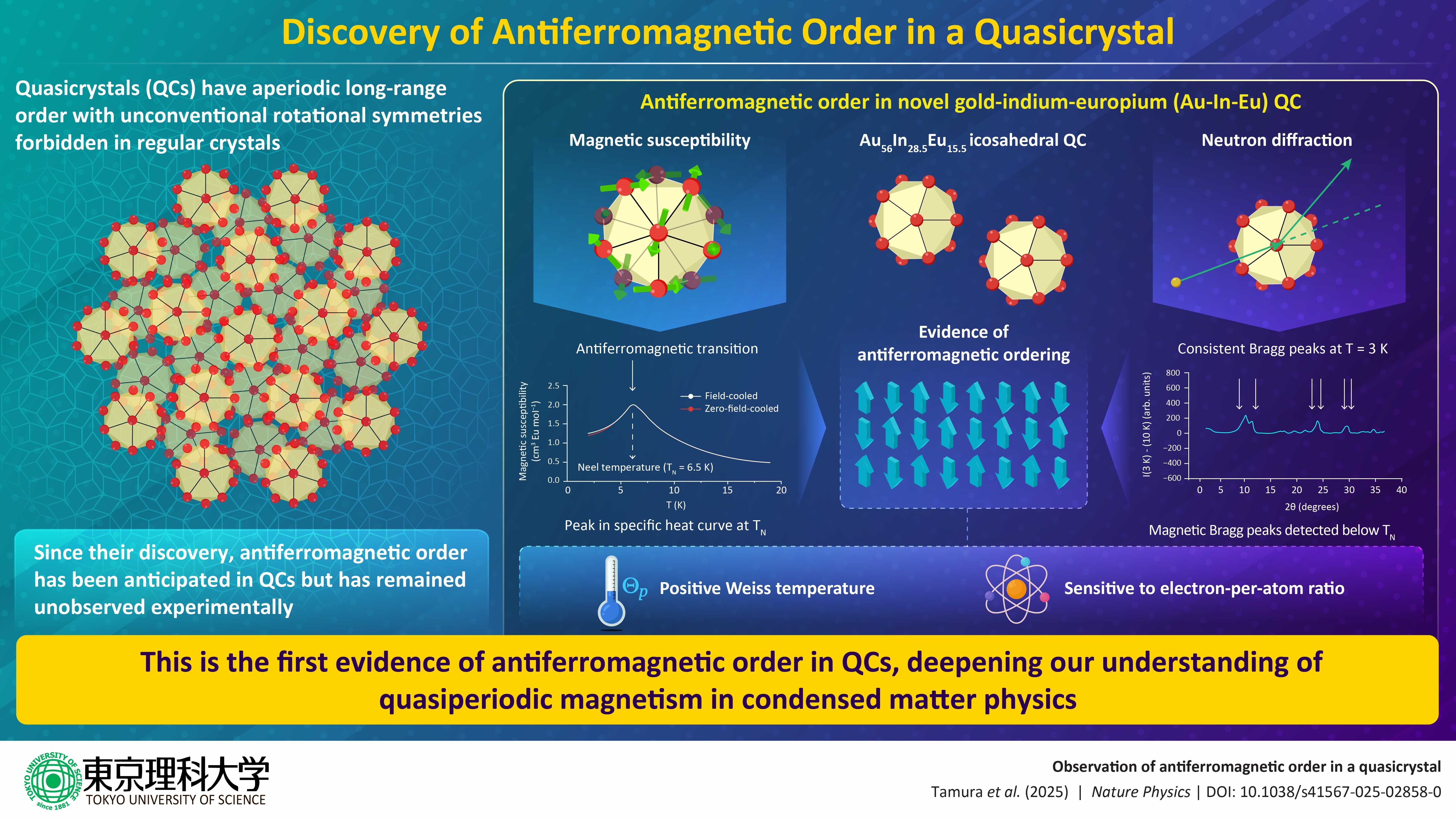business resources
Antiferromagnetic Quasicrystals Discovered: A Groundbreaking Step in Materials Science
15 Apr 2025, 1:46 pm GMT+1
Discovery of Antiferromagnetism
Researchers have discovered antiferromagnetism in a gold-indium-europium icosahedral quasicrystal, resolving a long-standing question in materials science. This breakthrough opens new possibilities for antiferromagnetic quasicrystals in spintronics and magnetic refrigeration. The findings suggest that controlling electron-per-atom ratios can tailor magnetic properties, advancing energy-efficient technologies.
In a significant breakthrough for materials science, researchers have discovered antiferromagnetism in an icosahedral quasicrystal (iQC), addressing a long-standing question in condensed matter physics. This discovery opens new avenues for spintronics and magnetic refrigeration, marking a key moment in the search for antiferromagnetic quasicrystals (AFM QCs).
A New Frontier for Quasicrystals
Quasicrystals, or QCs, are solid materials with an atomic arrangement that defies the traditional periodicity seen in conventional crystals. While regular crystals have repeating atomic patterns, QCs exhibit quasiperiodic symmetry—long-range order that does not repeat. Since their discovery, which earned a Nobel Prize, QCs have fascinated scientists, especially due to their potential applications in areas like spintronics and magnetic refrigeration.
Ferromagnetism, where magnetic moments align in the same direction, has been discovered in QCs, including in gold-gallium-rare earth (Au-Ga-R) icosahedral quasicrystals. However, the presence of antiferromagnetism, the opposite type of magnetic order where moments align in opposite directions, remained elusive until now. This discovery addresses the question of whether antiferromagnetic order can exist in such materials, as previous studies mainly showed spin-glass-like behaviour in magnetic QCs.
The Discovery of Antiferromagnetism in a Quasicrystal
A team led by Ryuji Tamura, from the Department of Materials Science and Technology at Tokyo University of Science (TUS), has finally observed antiferromagnetism in a real iQC. Their study, published in Nature Physics on April 14, 2025, describes the first direct evidence of antiferromagnetic order in a quasicrystal.
The team focused on a novel Tsai-type gold-indium-europium (Au-In-Eu) iQC, which exhibited multiple rotational symmetries—5-fold, 3-fold, and 2-fold. Using bulk property measurements, neutron experiments, and magnetic susceptibility measurements, they observed a sharp cusp at 6.5 Kelvin (K), consistent with an antiferromagnetic transition. The specific heat measurements also showed a peak at the same temperature, further confirming long-range magnetic order.

Confirming Long-Range Magnetic Order
To provide further validation, the researchers performed neutron diffraction measurements at temperatures of 10 K and 3 K. They discovered sharp magnetic Bragg peaks at 3 K, which confirmed the presence of a well-defined magnetic structure. These results mark the first clear evidence of antiferromagnetic order in a quasicrystal.
Unlike previously studied iQCs that displayed spin-glass behaviour with negative Curie-Weiss temperatures, the Au-In-Eu iQC exhibited a positive Curie-Weiss temperature. This observation suggests that iQCs with a positive Curie-Weiss temperature are more likely to host antiferromagnetic phases. Interestingly, when the electron-per-atom ratio was slightly increased through elemental substitution, the antiferromagnetic phase vanished, and the iQC reverted to a spin-glass state. This finding highlights the potential for controlling the magnetic properties of iQCs through careful manipulation of their composition.
Potential Implications for Future Technologies
David Tamura, lead author of the study, explains the significance of the discovery: “This discovery finally resolves the longstanding issue of whether antiferromagnetic order is possible in real QCs. Antiferromagnetic QCs could enable unprecedented functions, such as ultrasoft magnetic responses, and will bring about a revolution in spintronics and magnetic refrigeration in the future.”
Antiferromagnetic quasicrystals may enable advancements in energy-efficient technologies. The discovery supports the United Nations’ sustainable development goals (SDGs), particularly in the areas of affordable and clean energy (SDG 7) and innovation in infrastructure (SDG 9). By advancing energy-efficient electronics, these materials could help address pressing global challenges.
A Path Forward for Antiferromagnetic Quasicrystals
This breakthrough not only revitalises the search for antiferromagnetic quasicrystals but also opens up new possibilities in the field of quasiperiodic antiferromagnets. Researchers now have a clearer pathway to investigate and develop new materials with tailored magnetic properties, enabling innovations in areas such as quantum computing, magnetic sensors, and efficient energy use.
Max Avdeev, a co-author of the study from the Australian Nuclear Science and Technology Organisation and The University of Sydney, emphasises the importance of the discovery: “This research paves the way for further exploration of antiferromagnetic QCs and their potential applications. The future of materials science is evolving rapidly, and our findings are an essential step forward.”
About the Tokyo University of Science
The Tokyo University of Science (TUS) is a leading institution in Japan dedicated to advancing scientific research and education. Established in 1881, TUS has consistently contributed to the development of science and technology, producing groundbreaking research across a wide range of disciplines. It remains at the forefront of materials science research, with a strong emphasis on fostering innovation and interdisciplinary collaboration.
Share this
Himani Verma
Content Contributor
Himani Verma is a seasoned content writer and SEO expert, with experience in digital media. She has held various senior writing positions at enterprises like CloudTDMS (Synthetic Data Factory), Barrownz Group, and ATZA. Himani has also been Editorial Writer at Hindustan Time, a leading Indian English language news platform. She excels in content creation, proofreading, and editing, ensuring that every piece is polished and impactful. Her expertise in crafting SEO-friendly content for multiple verticals of businesses, including technology, healthcare, finance, sports, innovation, and more.
previous
How Inflation is Reshaping Insurance Policies: A Guide for Agencies
next
Networking, Community Building In The Digital Era: Dinis Guarda Interviews Thomas Power, Founder Of BIP100 Club